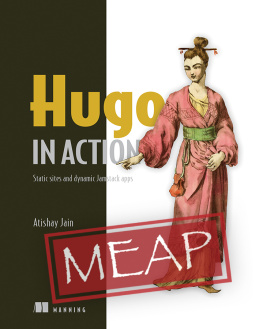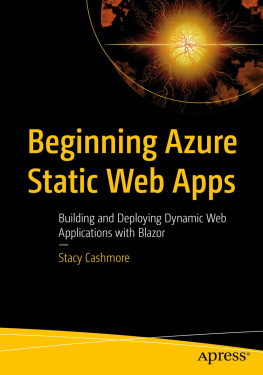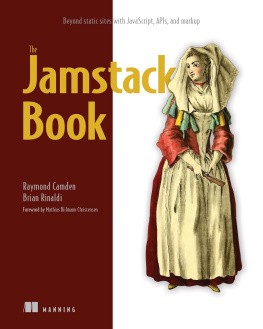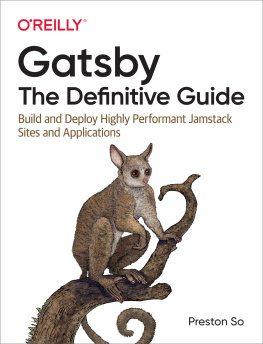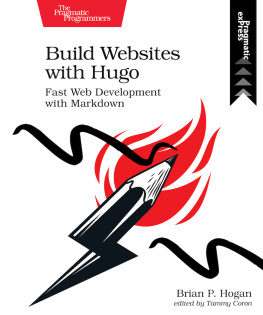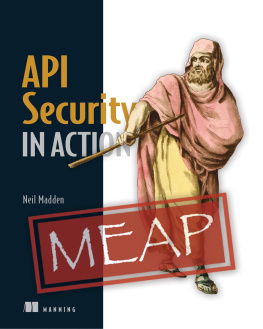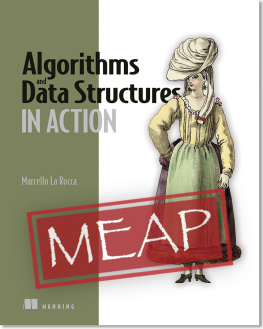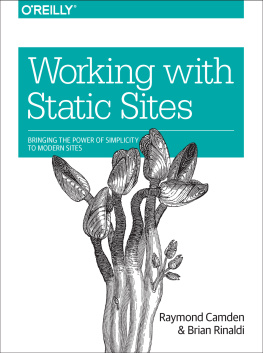Atishay Jain - Hugo in Action: Static sites and dynamic JAMstack apps MEAP V13
Here you can read online Atishay Jain - Hugo in Action: Static sites and dynamic JAMstack apps MEAP V13 full text of the book (entire story) in english for free. Download pdf and epub, get meaning, cover and reviews about this ebook. year: 2021, publisher: Manning Publications Co., genre: Computer. Description of the work, (preface) as well as reviews are available. Best literature library LitArk.com created for fans of good reading and offers a wide selection of genres:
Romance novel
Science fiction
Adventure
Detective
Science
History
Home and family
Prose
Art
Politics
Computer
Non-fiction
Religion
Business
Children
Humor
Choose a favorite category and find really read worthwhile books. Enjoy immersion in the world of imagination, feel the emotions of the characters or learn something new for yourself, make an fascinating discovery.
- Book:Hugo in Action: Static sites and dynamic JAMstack apps MEAP V13
- Author:
- Publisher:Manning Publications Co.
- Genre:
- Year:2021
- Rating:5 / 5
- Favourites:Add to favourites
- Your mark:
- 100
- 1
- 2
- 3
- 4
- 5
Hugo in Action: Static sites and dynamic JAMstack apps MEAP V13: summary, description and annotation
We offer to read an annotation, description, summary or preface (depends on what the author of the book "Hugo in Action: Static sites and dynamic JAMstack apps MEAP V13" wrote himself). If you haven't found the necessary information about the book — write in the comments, we will try to find it.
Atishay Jain: author's other books
Who wrote Hugo in Action: Static sites and dynamic JAMstack apps MEAP V13? Find out the surname, the name of the author of the book and a list of all author's works by series.
Hugo in Action: Static sites and dynamic JAMstack apps MEAP V13 — read online for free the complete book (whole text) full work
Below is the text of the book, divided by pages. System saving the place of the last page read, allows you to conveniently read the book "Hugo in Action: Static sites and dynamic JAMstack apps MEAP V13" online for free, without having to search again every time where you left off. Put a bookmark, and you can go to the page where you finished reading at any time.
Font size:
Interval:
Bookmark:


You can download the most up-to-date version of your electronic books from your Manning Account at .
Manning Publications Co. We welcome reader comments about anything in the manuscript - other than typos and other simple mistakes. These will be cleaned up during production of the book by copyeditors and proofreaders.
https://livebook.manning.com/#!/book/hugo-in-action/discussion
Thank you for purchasing the MEAP for Hugo in Action. I hope that this book helps you in sharpening your web development skills and provides you with success using Hugo and the Jamstack. To get the most benefit from this book, you will want to have some experience with programming, an understanding of common web terminology and some skills working with HTML and CSS. With this book you can take these skills to create a website with great performance and a very minimal ongoing maintenance overhead.
Hugo has been constantly ranked amongst the best static site builders in the last five years. It can compile a website in seconds and provide a huge and powerful standard library for writing templates. It has a strong community focused on building websites with high quality and great performance. I have crafted my personal website using a wide set of technologies from hand coded PHP to a WordPress instance. Then I migrated it to Jekyll and finally to Hugo. With Hugo, I have found a fine balance of features and performance. It is a framework that can help you focus on the joys of building websites. You will find yourself free from the ongoing frustrations of waiting for the live reload system to start or of updating and fixing security issues in the hundreds of plugins that your website relies on. With the core of the website standing on a stable framework, you can focus your efforts on utilizing the powers of Javascript and APIs for enhancing rather than maintaining your website.
This book navigates through the various hats a person needs to don to setup a modern website. In the first few chapters the readers will play the role of a content creator, an editor and a manager of an active Hugo based website. Through the middle of the book we will delve into theme creation, playing the role of the web developer to setup a beautiful website offering great performance. Towards the later half of the book, we will play the role of an integrator, a backend developer and an architect to setup a system which involves contacting first and third party services to enable server controller dynamic functionality in a primarily static website. This book navigates through the entire Jamstack starting with the Markup based pieces that form the core of the website and developing onto APIs and JavaScript.
The Jamstack has been the best stack for use in small websites including those belonging to individuals and small businesses. Cheap hosting along with freedom from day to day DevOps work make this ideal for websites that are ancillary to ones business. Even web based businesses are recognizing the power of this approach with more and more companies deciding to use markdown for the static portions of their website with the dynamic portions done using JavaScript talking over a clean API.
Please let me know your thoughts on my approach to helping you learn Hugo using the liveBook's Discussion Forum. Your feedback has the power to change the course of the book and I am keenly waiting for your comments.
Thanks again for purchasing Hugo in Action MEAP.
Atishay Jain

Appendixes:
Are you looking for a website that is fast, flexible, fully automated, and fun to build? Part 1 of Hugo in Action will get you one - a static website that can load instantly all across the planet and works with minimal operational overhead.
Chapter 2 will get up with our build environment and a functional website deployed to production. We will also discuss how to keep a tab on the performance and keep our maintenance work low. Chapter 3 will take us deep into authoring with Markdown and YAML for content and metadata, respectively. We will use Markdowns formatting capabilities and Hugos extensions on its top to prepare our pages to be presented on the internet. In chapter 4, we will don the hat of the website editor. Hugo will show how with the Jamstack, we can rethink our content organization to be very intuitive.
In chapter 5, we shift gears and get into the developer role. We will witness the Go template languages power and the massive library of functions that it has been adorned with by Hugo. We will see how we can use Hugo templates for everything - from extending Markdown to automating repeatable work for the content author. In Chapter 6, the development moves from a single web page to an entire section. On the web - sharing is caring - as most pages share significant parts of their UI and code. Chapter 6 has the ins and outs of sharing templates and content within a website Hugo.
In chapter 7, we become independent of the external theme we have used since chapter 2. Here we dive into the internals of Hugos model for web development and understand how Hugo has set up all the features we have used as an editor. Chapter 8 adds a whole new direction to sharing, where we go beyond a single website into sharing content, templates, and code across multiple websites. Hugo Modules is a plugin system for everybody - from content authors to editors and user interface to business logic developers.
At the end of part 1, we will have a fast and flexible website. We will also have experience using some of the best techniques to ensure it remains fast without heavy investment in operations.
This chapter covers
Basics of the Jamstack for building websites
Principles of static site generators
Understanding the Hugo static site generator
Benefits of the Hugo static site generator
Use cases best suited for the Jamstack and Hugo
If you have been associated with websites recently or have friends in similar positions, you must have known how much work is involved in maintaining a website. It needs DevOps engineers, system administrators, and database architects to keep a website running on the internet. It is a full-time job for an entire team, not just an individual. The upkeep of content is so time-consuming that the creators have been moving at an unprecedented rate to managed hosting services like WordPress.com or even giving away their content to platforms like Medium or Facebook.
The Jamstack provides a way of doing web development that minimizes the day-to-day overhead of maintaining websites. The term was coined by the co-founder and CEO of Netlify, Matt Biilmann, in 2016. It forgoes databases by storing all the content into files compiled during deployment and then distributed over a Content Delivery Network (CDN). Application Programming Interfaces provide dynamic, server-based content (APIs) maintained by third parties or hosted by a cloud service provider with minimal day-to-day involvement by the website owner. This way, developers are free from the tasks of handling security updates, denial-of-service (DoS) attacks, and the constant monitoring required to keep hackers at bay.
Next pageFont size:
Interval:
Bookmark:
Similar books «Hugo in Action: Static sites and dynamic JAMstack apps MEAP V13»
Look at similar books to Hugo in Action: Static sites and dynamic JAMstack apps MEAP V13. We have selected literature similar in name and meaning in the hope of providing readers with more options to find new, interesting, not yet read works.
Discussion, reviews of the book Hugo in Action: Static sites and dynamic JAMstack apps MEAP V13 and just readers' own opinions. Leave your comments, write what you think about the work, its meaning or the main characters. Specify what exactly you liked and what you didn't like, and why you think so.

